Analysis of the Spatiotemporal Changes in Cropland Occupation and Supplementation Area in the Pearl River Delta and Their Impacts on Carbon Storage
Abstract
:1. Introduction
2. Materials and Methods
2.1. Study Area
2.2. Data Sources
3. Transportation Location Data
3.1. Quantitative Characteristics of Cultivated Land Changes
3.1.1. Characteristics of Farmland Change Quantity
3.1.2. Land Use Transition Matrix
3.2. Calculation of Carbon Stock—InVEST Model
3.2.1. Total Carbon Stock
3.2.2. Carbon Density Data
3.3. Carbon Stock Hot Spot Analysis
3.4. Land Use Change—PLUS Model
- (1)
- Accuracy Verification. The Kappa index is a metric used to measure classification accuracy, assessing the agreement between the model’s predictions and actual classifications. The Kappa index ranges from [0,1], where a value greater than 0.7 indicates high reliability of the model. The larger the Kappa index, the higher the model’s accuracy, and the closer the predictions are to reality. The calculation formula is as follows:where P0 represents the observed accuracy and Pe represents the expected accuracy under random conditions.
- (2)
- The multi-scenario analysis [3,40] involves simulating land cover changes in the PRD region from 2000 to 2020 based on different scenarios: natural development, urban development, farmland protection, and ecological priority. The restricted area is defined based on the “Guangdong Wetland Protection Regulations” (2022 Revision), incorporating wetland area control goals into the ecological protection red line according to the law. Hence, this study designates marshland in water bodies and unused land as restricted areas. ① The natural succession scenario follows the natural development trend observed from 2000 to 2020. ② In the Pearl River Delta, the urban development scenario emphasizes economic expansion, industrialization, and urbanization. It increases the likelihood of converting farmland, forestland, and meadows to urban areas by 30%, while it decreases the probability of converting urban areas to other land types (excluding farmland) by 30%. ③ The ecological priority scenario will aim to enhance the conversion of other land types into ecological land and to slow down the conversion out of ecological land to achieve ecological protection. Under this scenario, all land types, except urban land, will be eligible for conversion. The probability of converting woodland and grassland to urban land will decrease by 50%, while the probability of converting farmland to urban land will decrease by 30%. Conversely, the probability of converting farmland and grassland to woodland will increase by 30%. ④ The farmland protection scenario aims to protect farmland by slowing down the rate of conversion from farmland to other land types or urban land. Hence, the probability of farmland conversion to urban and rural construction land decreases by 60%, and the probability of conversion from farmland to woodland, grassland, and water bodies decreases by 30%. This scenario is used to predict the land use status in 2030 under farmland protection conditions.
- (3)
- Model Parameter Configuration
4. Results
4.1. Analysis of the Balance of Cultivated Land Requisition–Compensation in the Pearl River Delta
4.2. Impact of Changes in Various Land Types on Carbon Storage
4.3. Temporal and Spatial Distribution of Carbon Storage in Cultivated Land Occupation and Compensation
4.4. Hot Spot Analysis of Carbon Storage Changes Due to Land Conversion
4.5. Simulation of Land Use in Different Scenarios and Prediction of Carbon Storage
5. Discussion
5.1. The Impact of Land Use Balance Policy on the Spatiotemporal Distribution of Carbon Stock
5.2. The Regional Disparities in the Impact of Changes in Farmland Occupation and Compensation on Carbon Storage
5.3. The Innovative Aspects, Limitations, and Prospects of the Study Are as Follows
6. Conclusions
- (1)
- In 2000, 2010, and 2020, the cropland area in the Pearl River Delta was 14,514.99 km2, 12,715.09 km2, and 12,162.46 km2, respectively. The net change rate of cropland area from 2000 to 2020 was −0.81%, with a decrease of 16.49 km2. The lost cropland was mainly occupied by construction land and forest land.
- (2)
- The pattern of low values in the center and high values around the periphery is exhibited by the carbon storage in the Pearl River Delta region. The terrestrial ecosystem carbon storage in the Pearl River Delta for 2000, 2010, and 2020 was 534.62 × 106 t, 518.60 × 106 t, and 512.57 × 106 t, respectively. The regional carbon storage shows a decreasing trend year by year. The conversion of cropland and forest land is the main reason for the decline in total carbon storage in the Pearl River Delta region.
- (3)
- Over the 20-year period, changes in carbon storage were most significant. The carbon sequestration area occupied by cropland was significantly larger than the carbon loss area compensated by cropland, with the carbon loss concentrated in the more developed central regions and scattered around the periphery. The carbon sequestration areas were mainly concentrated in the southern part of Foshan. The imbalance in the quality of cropland occupation and compensation is an important reason for regional carbon loss.
- (4)
- Among different scenario simulations, the urban development scenario is an important driving factor causing carbon loss, while ecological protection is the driving force promoting carbon sequestration. The ecological priority scenario is a relatively optimal development scenario. In this scenario, the expansion of construction land and the reduction in ecological land such as cropland and forest land are effectively controlled, resulting in minimal carbon storage loss.
Author Contributions
Funding
Data Availability Statement
Acknowledgments
Conflicts of Interest
References
- Han, L.; Peng, M.; Jiang, R.; Xu, B.; Zhang, B.; Chen, M. The Logical Roots, Model Exploration and Management Innovation of Farmland Occupation and Compensation Balance in the New Era—Reflections Based on the “Seminar on Improvement and Management Innovation of Farmland Occupation and Compensation Balance in the New Era”. China Land Sci. 2018, 32, 90–96. [Google Scholar]
- Fan, M.; Wang, Z.; Xue, Z. Spatiotemporal evolution characteristics, influencing factors of land use carbon emissions, and low-carbon development in Hubei Province, China. Ecol. Inform. 2024, 81, 102567. [Google Scholar] [CrossRef]
- Zhao, Q.; Xie, B.; Han, M. Unpacking the Sub-Regional Spatial Network of Land-Use Carbon Emissions: The Case of Sichuan Province in China. Land 2023, 12, 1927. [Google Scholar] [CrossRef]
- Li, X.; Hu, S.; Jiang, L.; Han, B.; Li, J.; Wei, X. Spatiotemporal Patterns and the Development Path of Land-Use Carbon Emissions from a Low-Carbon Perspective: A Case Study of Guizhou Province. Land 2023, 12, 1875. [Google Scholar] [CrossRef]
- Abdul, M.F.; Riad, S.M.; Yad, S.M. Impacts of land use-based carbon emission pattern on surface temperature dynamics: Experience from the urban and suburban areas of Khulna, Bangladesh. Remote Sens. Appl. Soc. Environ. 2021, 22, 100485. [Google Scholar]
- Dionizio, E.A.; Pimenta, F.M.; Lima, L.B.; Costa, M.H. Carbon stocks and dynamics of different land uses on the Cerrado agricultural frontier. PLoS ONE 2020, 15, e0241637. [Google Scholar] [CrossRef]
- Zhao, L.; Zhang, C.F.; Wang, Q.; Yang, C.H.; Suo, X.X.; Zhang, Q.P. Climate extremes and land use carbon emissions: Insight from the perspective of sustainable land use in the eastern coast of China. J. Clean. Prod. 2024, 452, 142219. [Google Scholar] [CrossRef]
- Zhang, X.M.; Fan, H.B.; Hou, H.; Xu, C.Q.; Sun, L.; Li, Q.Y.; Ren, J.Z. Spatiotemporal evolution and multi-scale coupling effects of land-use carbon emissions and ecological environmental quality. Sci. Total Environ. 2024, 922, 171149. [Google Scholar] [CrossRef] [PubMed]
- Wei, W.; Li, Y.Y.; Ma, L.B.; Xie, B.B.; Hao, R.J.; Chen, D.B.; Yang, S.L. Carbon emission change based on land use in Gansu Province. Environ. Monit. Assess. 2024, 196, 311. [Google Scholar] [CrossRef]
- Zhang, R.J.; Yu, K.H.; Luo, P.P. Spatio-Temporal Relationship between Land Use Carbon Emissions and Ecosystem Service Value in Guanzhong, China. Land 2024, 13, 118. [Google Scholar] [CrossRef]
- Liu, C.X.; Xu, R.; Xu, K.J.; Lin, Y.W.; Cao, Y.G. Carbon Emission Effects of Land Use in Chaobai River Region of Beijing–Tianjin–Hebei, China. Land 2023, 12, 1168. [Google Scholar] [CrossRef]
- Wani, O.A.; Kumar, S.S.; Hussain, N.; Wani, A.I.A.; Babu, S.; Alam, P.; Rashid, M.; Popescu, S.M.; Mansoor, S. Multi-scale Processes Influencing Global Carbon Storage and Land-Carbon-Climate Nexus: A Critical Review. Pedosphere 2023, 33, 250–267. [Google Scholar] [CrossRef]
- Hernández-Guzmán, R.; Ruiz-Luna, A.; González, C. Assessing and Modeling the Impact of Land Use and Changes in Land Cover Related to Carbon Storage in a Western Basin in Mexico. Remote Sens. Appl. Soc. Environ. 2019, 13, 318–327. [Google Scholar] [CrossRef]
- Robinson, D.T.; Zhang, J.X.; MacDonald, D.; Samson, C. Estimating Settlement Carbon Stock and Density Using an Inventory Approach and Quantifying Their Variation by Land Use and Parcel Size. Urban For. Urban Green. 2023, 82, 127878. [Google Scholar] [CrossRef]
- Thakur, T.K.; Swamy, S.L.; Thakur, A.; Mishra, A.; Bakshi, S.; Kumar, A.; Altaf, M.M.; Kumar, R. Land Cover Changes and Carbon Dynamics in Central India’s Dry Tropical Forests: A 25-Year Assessment and Nature-Based Eco-Restoration Approaches. J. Environ. Manag. 2024, 351, 119809. [Google Scholar] [CrossRef] [PubMed]
- Chalchissa, F.B.; Kuris, B.K. Modeling Soil Organic Carbon Dynamics under Extreme Climate and Land Use and Land Cover Changes in Western Oromia Regional State, Ethiopia. J. Environ. Manag. 2024, 350, 119598. [Google Scholar] [CrossRef]
- Gutierrez, S.; Grados, D.; Moller, A.B.; Gomes, L.D.; Beucher, A.M.; Giannini-Kurina, F.; de Jonge, L.W.; Greve, M.H. Unleashing the sequestration potential of soil organic carbon under climate and land use change scenarios in Danish agroecosystems. Sci. Total Environ. 2023, 905, 166921. [Google Scholar] [CrossRef] [PubMed]
- Sahu, C.; Mishra, R.; Basti, S. Land-Use Change Affects Carbon Storage and Lability in Tropical Soil of India. Geoderma Reg. 2023, 32, e00621. [Google Scholar] [CrossRef]
- Aquino, D.S.; Gavier-Pizarro, G.; Rescia, A.J.; Quintana, R.D. Wetland responses to non-stationary hydro-climatic dynamics in the context of land cover and land use change. Remote Sens. Appl. Soc. Environ. 2024, 34, 101156. [Google Scholar] [CrossRef]
- Nohemi, G.S.; Selene, O.O.; Oscar, E.; Priscila, M.O. Analysis of the Relationship between Land Use Change and Piezometric Levels in the Basin of Mexico. J. S. Am. Earth Sci. 2024, 136, 104817. [Google Scholar] [CrossRef]
- Colman, C.B.; Guerra, A.; Almagro, A.; Roque, F.D.; Rosa, I.M.D.; Fernandes, G.W.; Oliveira, P.T.S. Modeling the Brazilian Cerrado Land Use Change Highlights the Need to Account for Private Property Sizes for Biodiversity Conservation. Sci. Rep. 2024, 14, 4559. [Google Scholar] [CrossRef] [PubMed]
- Gao, F.J.; Xin, X.H.; Song, J.X.; Li, X.W.; Zhang, L.; Zhang, Y.; Liu, J.F. Simulation of LUCC Dynamics and Estimation of Carbon Stock under Different SSP-RCP Scenarios in Heilongjiang Province. Land 2023, 12, 1665. [Google Scholar] [CrossRef]
- Xie, L.J.; Bai, Z.K.; Yang, B.Y.; Fu, S. Simulation Analysis of Land-Use Pattern Evolution and Valuation of Terrestrial Ecosystem Carbon Storage of Changzhi City, China. Land 2022, 11, 1270. [Google Scholar] [CrossRef]
- Josephine, M. Environmental Integrity of Forest Offsets in a Changing Climate: Embedding Future Climate in Australia’s Sinks Policy Regime. J. Environ. Plan. Manag. 2024, 67, 1328–1346. [Google Scholar] [CrossRef]
- Ge, J.; Lin, B. Convergence or Divergence? Unraveling the Global Development Pattern of Forest Carbon Sink. Environ. Impact Assess. Rev. 2024, 105, 107442. [Google Scholar] [CrossRef]
- Mo, L.D.; Zohner, C.M.; Reich, P.B.; Liang, J.J.; de Miguel, S.; Nabuurs, G.J.; Renner, S.S.; van den Hoogen, J.; Araza, A.; Herold, M.; et al. Integrated Global Assessment of the Natural Forest Carbon Potential. Nature 2023, 624, 92–101. [Google Scholar] [CrossRef] [PubMed]
- Lv, T.G.; Geng, C.; Zhang, X.M.; Li, Z.Y.; Hu, H.; Fu, S.F. Impact of the Intensive Use of Urban Construction Land on Carbon Emission Efficiency: Evidence from the Urban Agglomeration in the Middle Reaches of the Yangtze River. Environ. Sci. Pollut. Res. 2023, 30, 113729–113746. [Google Scholar] [CrossRef]
- Song, S.X.; Kong, M.L.; Su, M.J.; Ma, Y.X. Study on Carbon Sink of Cropland and Influencing Factors: A Multiscale Analysis Based on Geographical Weighted Regression Model. J. Clean. Prod. 2024, 447, 141455. [Google Scholar] [CrossRef]
- Li, Y.Y.; Xue, C.X.; Chai, C.Q.; Li, W.; Li, N.; Yao, S.B. Influencing Factors and Spatiotemporal Heterogeneity of Net Carbon Sink of Conservation Tillage: Evidence from China. Environ. Sci. Pollut. Res. 2023, 30, 110913–110930. [Google Scholar] [CrossRef]
- Leifeld, J. Carbon Farming: Climate Change Mitigation via Non-Permanent Carbon Sinks. J. Environ. Manag. 2023, 339, 117893. [Google Scholar] [CrossRef]
- Kong, J.Q.; Chen, L.F. The Changes in Cropland Pattern Enhanced Carbon Storage in Northwest China. Agronomy 2023, 13, 2736. [Google Scholar] [CrossRef]
- Chen, C.; Xu, Y.F. Impacts, carbon effects, and forecasts for cropland expansion in the Northern Tianshan Mountain Economic Zone. Environ. Monit. Assess. 2024, 196, 7. [Google Scholar] [CrossRef] [PubMed]
- Schierhorn, F.; Müller, D.; Beringer, T.; Prishchepov, A.V.; Kuemmerle, T.; Balmann, A. Post-Soviet Cropland Abandonment and Carbon Sequestration in European Russia, Ukraine, and Belarus. Glob. Biogeochem. Cycles 2013, 27, 1175–1185. [Google Scholar] [CrossRef]
- Song, W.; Liu, M. Farmland Conversion Decreases Regional and National Land Quality in China. Land Degrad. Dev. 2017, 28, 459–471. [Google Scholar] [CrossRef]
- Ke, X.; van Vliet, J.; Zhou, T.; Verburg, P.H.; Zheng, W.; Liu, X. Direct and indirect loss of natural habitat due to built-up area expansion: A model-based analysis for the city of Wuhan, China. Land Use Policy 2018, 74, 231–239. [Google Scholar] [CrossRef]
- Ke, X.; Tang, L. Impact of coupling urban expansion and farmland protection on carbon storage of terrestrial ecosystems: A case study in Hubei Province, China. Acta Ecol. Sin. 2019, 39, 672–683. [Google Scholar]
- Tang, L.P.; Ke, X.L.; Zheng, W.W. Scenario Analysis of the Impact of Farmland Occupation and Compensation Balance on Carbon Storage. Land Econ. Res. 2020, 2, 76–93. [Google Scholar]
- He, Q.S.; Jiang, X. Measurement of the Impact of Temporal and Spatial Changes in Farmland Occupation and Compensation Area on Carbon Storage: A Case Study of Hubei Province. Acta Ecol. Sin. 2023, 43, 10413–10429. [Google Scholar] [CrossRef]
- Zheng, H.; Zheng, H. Evaluation and prediction of carbon storage in the Guangdong-Hong Kong-Macao Greater Bay Area based on land use/land cover dynamic changes. Environ. Sci. 2024, 45, 2321–2331. [Google Scholar] [CrossRef]
- Peng, Y.; Cheng, W.; Xu, X.; Song, H. Analysis and prediction of the spatiotemporal characteristics of land-use ecological risk and carbon storage in Wuhan metropolitan area. Ecol. Indic. 2024, 158, 111432. [Google Scholar] [CrossRef]
- Wang, B.; Liao, J.; Zhu, W. Neighborhood weight setting of FLUS model based on historical scenarios: A case study of land use simulation in 2030 for the Minnan-Triangle Urban Agglomeration. Acta Ecol. Sin. 2019, 39, 4284–4298. [Google Scholar]
- Ye, X.; Chuai, X. Carbon Sinks/Sources’ Spatiotemporal Evolution in China and Its Response to Built-Up Land Expansion. J. Environ. Manag. 2022, 321, 115863. [Google Scholar] [CrossRef] [PubMed]
- Fu, Y.; He, Y.; Chen, W.; Xiao, W.; Ren, H.; Shi, Y.; Hu, Z. Dynamics of Carbon Storage Driven by Land Use/Land Cover Transformation in Coal Mining Areas with a High Groundwater Table: A Case Study of Yanzhou Coal Mine, China. Environ. Res. 2024, 247, 118392. [Google Scholar] [CrossRef] [PubMed]
- Schulp, C.J.E.; Nabuurs, G.-J.; Verburg, P.H. Future carbon sequestration in Europe—Effects of land use change. Agric. Ecosyst. Environ. 2008, 127, 251–264. [Google Scholar] [CrossRef]
- Eve, M.D.; Sperow, M.; Howerton, K.; Paustian, K.; Follett, R.F. Predicted impact of management changes on soil carbon storage for each cropland region of the conterminous United States. J. Soil Water Conserv. 2002, 57, 196–204. [Google Scholar]
- Lin, J.; Li, X.; Wen, Y.; He, P. Modeling urban land-use changes using a landscape-driven patch-based cellular automaton (LP-CA). Cities 2023, 132, 103906. [Google Scholar] [CrossRef]

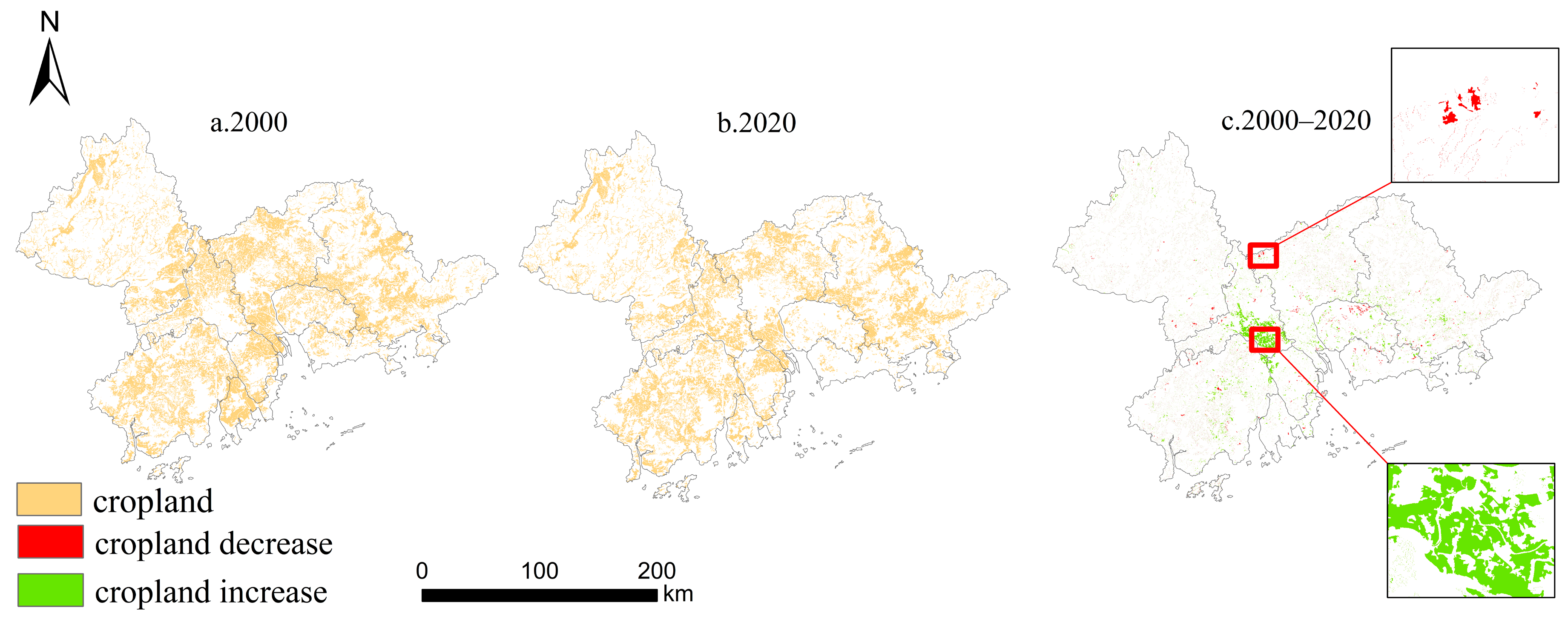
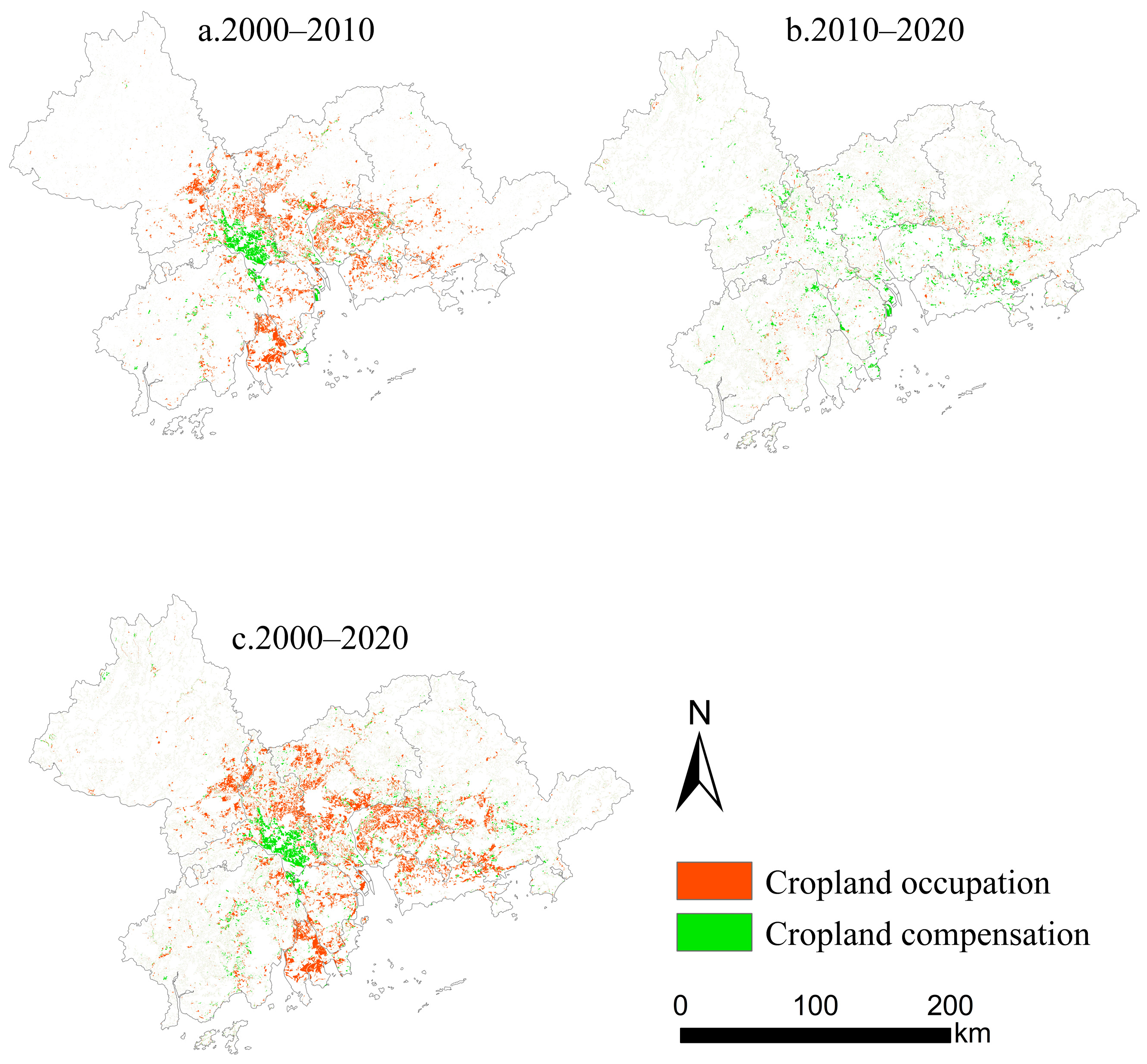
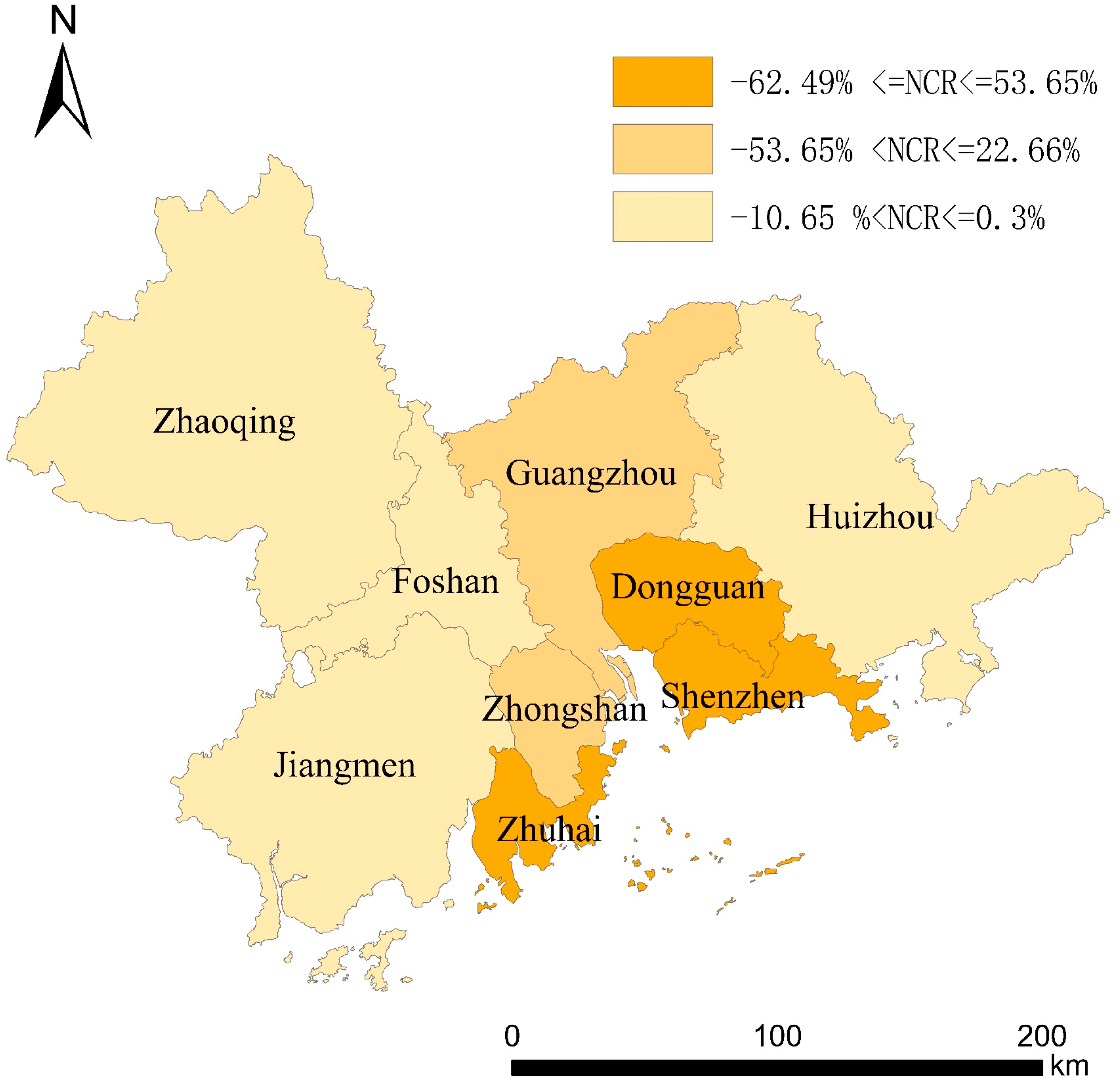

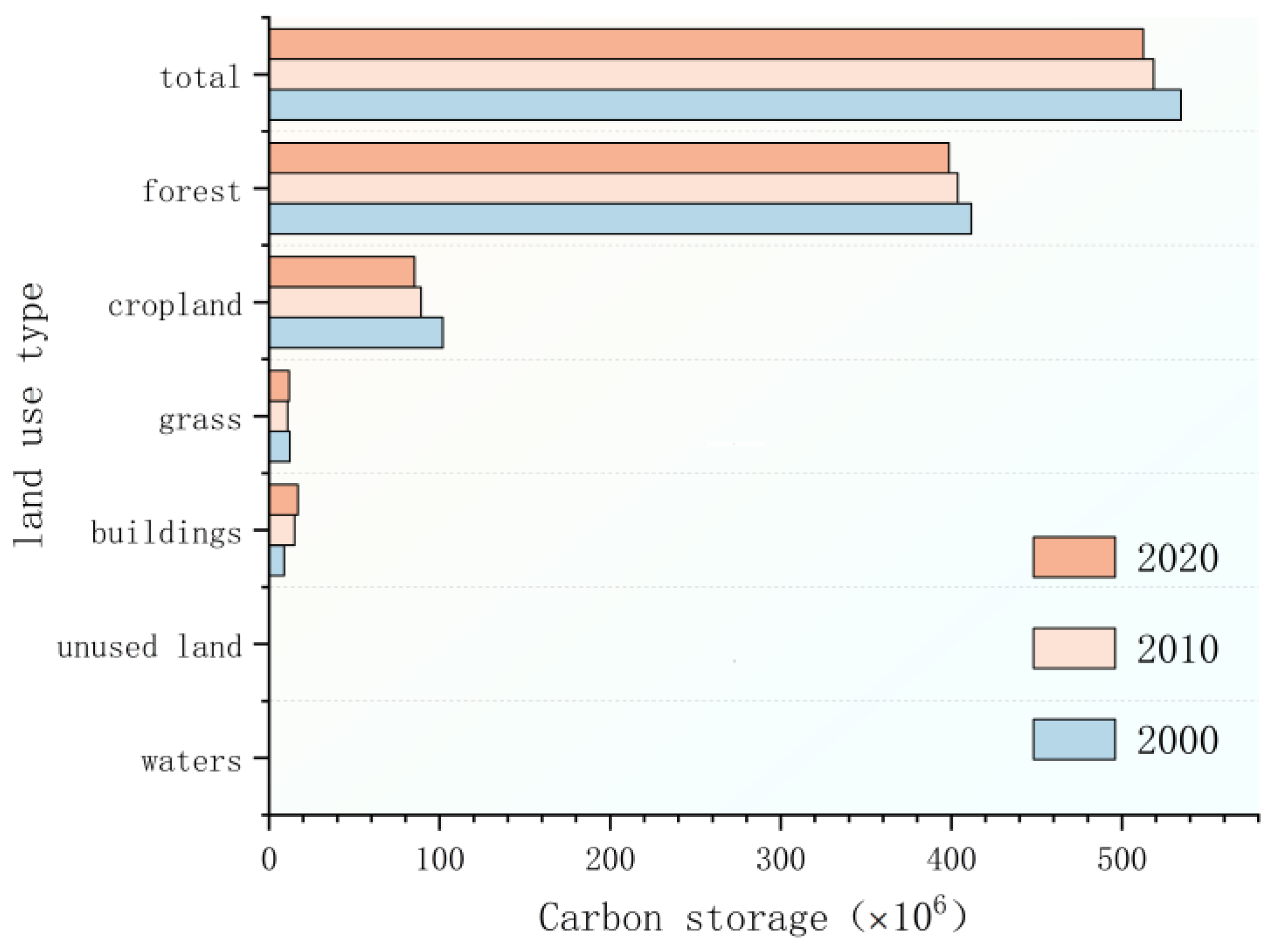

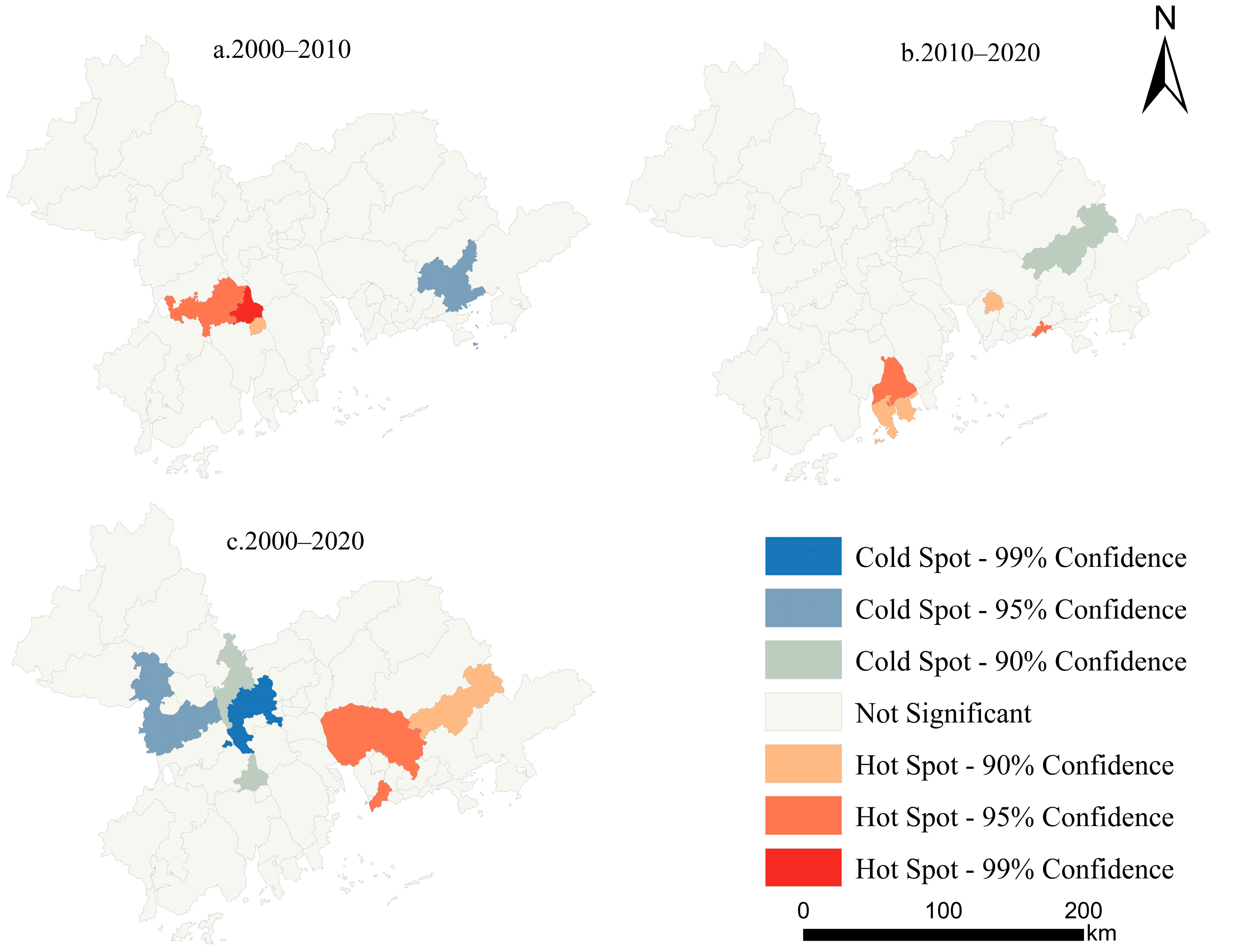

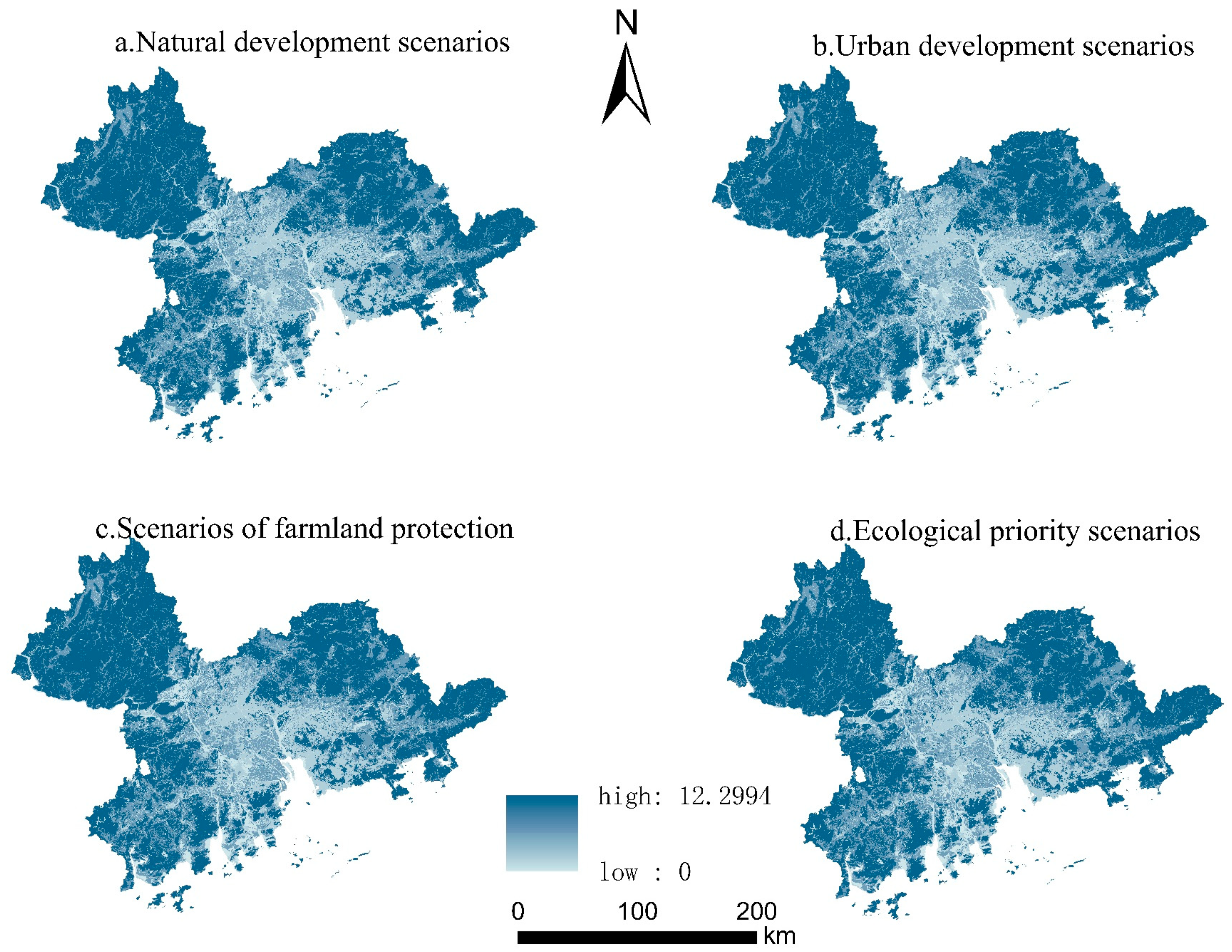
| Data Category | Data Name | Data Source | Data Accuracy/m |
|---|---|---|---|
| Base Data | Land Cover Data for 3 Periods | http://www.resdc.cn/ | 30 |
| Restricted conversion zone | Land Use Restriction Factors | ArcGIS reclassification: 0—restriction conversion; 1—other | 30 |
| Socioeconomic data | Population density | http://www.resdc.cn/ | 1000 |
| GDP | http://www.resdc.cn/ | 1000 | |
| Natural factor data | Annual mean temperature | http://www.resdc.cn/ | 1000 |
| Annual average precipitation | http://www.resdc.cn/ | 1000 | |
| Soil type | http://www.resdc.cn/ | 1000 | |
| DEM | Geospatial Data Cloud | 30 | |
| Slope | From DEM | 30 | |
| Aspect | From DEM | 30 | |
| Translates to “transportation data” | Distance to main road | OpenStreetMap | 500 |
| Distance to secondary road | OpenStreetMap | 500 | |
| Distance to railway | OpenStreetMap | 500 | |
| Distance to water bodies | OpenStreetMap | 500 |
| Land Use Type | C_Above | C_Above | C_Soil | C_Dead |
|---|---|---|---|---|
| Cultivated land | 6.11 | 5.26 | 57.83 | 1.32 |
| Woodland | 28.38 | 10.82 | 95.35 | 2.11 |
| Grassland | 14.29 | 15.19 | 75.7 | 8.46 |
| Waters | 0 | 0 | 0 | 0 |
| Building land | 0 | 0 | 20.78 | 0 |
| Unused land | 1.96 | 0 | 15.88 | 0 |
| Ocean | 6.11 | 5.26 | 57.83 | 1.32 |
| Type of Cultivated Land Occupation and Compensation | Period | |||
|---|---|---|---|---|
| 2000–2010 | 2010–2020 | 2000–2020 | ||
| Cultivated Land Occupation | Cropland–Woodland | 200.37 | 277.50 | 390.08 |
| Cropland–Grassland | 6.58 | 21.14 | 46.74 | |
| Cropland–Waters | 653.81 | 213.58 | 778.23 | |
| Cropland–Buildings | 1786.22 | 857.81 | 2463.39 | |
| Cropland–Unused land | 0.14 | 0.21 | 0.22 | |
| Total | 2647.12 | 1370.22 | 3678.66 | |
| Cultivated Land Compensation | Woodland–Cropland | 146.75 | 300.49 | 385.73 |
| Grassland–Cropland | 10.13 | 17.92 | 24.78 | |
| Waters–Cropland | 552.68 | 126.05 | 573.81 | |
| Buildings–Cropland | 129.89 | 372.89 | 340.45 | |
| Unused land–Cropland | 2.12 | 0.50 | 0.96 | |
| Total | 841.56 | 817.85 | 1325.73 | |
| Dynamicity of Farmland Changes | −1.24% | −0.43% | −0.81 | |
| Type of Cultivated Land Occupation and Compensation | Period × 106/t | |||
|---|---|---|---|---|
| 2000–2010 | 2010–2020 | 2000–2020 | ||
| Cultivated Land Occupation | Cropland–Woodland | 1.40 | 1.95 | 2.73 |
| Cropland–Grassland | 0.05 | 0.15 | 0.33 | |
| Cropland–Waters | −4.58 | −1.50 | −5.46 | |
| Cropland–Building | −12.52 | −6.01 | −17.27 | |
| Cropland–Unused land | −0.0010 | −0.0015 | −0.0016 | |
| Total | −15.65 | −5.42 | −19.67 | |
| Cultivated Land Compensation | Woodland–Cropland | −1.99 | −4.08 | −5.24 |
| Grassland–Cropland | −0.11 | −0.20 | −0.28 | |
| Waters–Cropland | 4.02 | 3.87 | 4.02 | |
| Building–Cropland | 0.27 | 0.77 | 0.70 | |
| Unused land–Cropland | 0.0038 | 0.0009 | 0.0017 | |
| Total | 2.18 | 0.36 | −0.80 | |
| Land Use Scenarios | Cropland | Woodland | Grassland | Waters | Buildings | Unused Land | Carbon Stock |
|---|---|---|---|---|---|---|---|
| 2020 Actual Demand | 12,160.32 | 29,323.66 | 1041.33 | 4014.99 | 8159.34 | 6.82 | 512.57 |
| 2030 Natural Development Scenario | 11,711.68 | 28,961.63 | 1121.73 | 3934.74 | 8972.31 | 4.39 | 496.92 |
| 2030 Urban Development Scenario | 11,560.36 | 28,803.03 | 1091.64 | 3891.84 | 9355.24 | 4.38 | 494.40 |
| 2030 Farmland Protection Scenario | 12,351.03 | 28,882.02 | 1115.67 | 3873.44 | 8479.99 | 4.33 | 499.60 |
| 2030 Ecological Priority Scenario | 11,877.58 | 29,271.62 | 1140.20 | 3938.92 | 8473.76 | 4.40 | 503.24 |
| Natural Development Scenario Change Rate | −3.69 | −1.23 | 7.72 | −2.00 | 9.96 | 35.66 | −3.05 |
| Urban Development Scenario Change Rate | −4.93 | −1.78 | 4.83 | −3.07 | 14.66 | 35.88 | −3.54 |
| The Change Rate under the Farmland Protection Scenario | 1.57 | −1.51 | 7.14 | −3.53 | 3.93 | 36.58 | −2.53 |
| The Change Rate under the Ecological Priority Scenario | −2.33 | −0.18 | 9.49 | −1.89 | 3.85 | 35.58 | −1.82 |
Disclaimer/Publisher’s Note: The statements, opinions and data contained in all publications are solely those of the individual author(s) and contributor(s) and not of MDPI and/or the editor(s). MDPI and/or the editor(s) disclaim responsibility for any injury to people or property resulting from any ideas, methods, instructions or products referred to in the content. |
© 2024 by the authors. Licensee MDPI, Basel, Switzerland. This article is an open access article distributed under the terms and conditions of the Creative Commons Attribution (CC BY) license (https://creativecommons.org/licenses/by/4.0/).
Share and Cite
Huang, S.-Q.; Wu, D.-F.; Lin, J.-Y.; Pan, Y.-L.; Zhou, P. Analysis of the Spatiotemporal Changes in Cropland Occupation and Supplementation Area in the Pearl River Delta and Their Impacts on Carbon Storage. Land 2024, 13, 1195. https://doi.org/10.3390/land13081195
Huang S-Q, Wu D-F, Lin J-Y, Pan Y-L, Zhou P. Analysis of the Spatiotemporal Changes in Cropland Occupation and Supplementation Area in the Pearl River Delta and Their Impacts on Carbon Storage. Land. 2024; 13(8):1195. https://doi.org/10.3390/land13081195
Chicago/Turabian StyleHuang, Shu-Qi, Da-Fang Wu, Jin-Yao Lin, Yue-Ling Pan, and Ping Zhou. 2024. "Analysis of the Spatiotemporal Changes in Cropland Occupation and Supplementation Area in the Pearl River Delta and Their Impacts on Carbon Storage" Land 13, no. 8: 1195. https://doi.org/10.3390/land13081195





